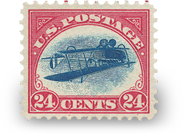| Introduction | Why Grade Stamps? | What is Grading? | PSE Grading System | Soundness | Centering | Combining Soundness and Centering | Eye Appeal | Gum Condition | Appendix |
In a nutshell, grading is the process of grouping stamps of a given Scott number and state, (e.g., Used, Mint NH, Mint OG, etc) with a similar fair market value into discrete categories. For example, a used Scott No. 1 worth in the $150 to $200 range would fall into the "Good" category, one that might sell in the $300 to $400 category would be "Fine," a $500 to $700 copy might be graded "Very Fine" and a $1,500 example would likely qualify as "Superb." Because some lower grade used stamps are worth more than higher grade mint examples (e.g., Scott No. 39) and because of the large premium afforded to "never hinged" stamps, comparisons are only valid among stamps of the same state.
PSE does not grade FAKE or ALTERED stamps. Common items which fall into this category include fake early coils, early 19th century used stamps which have had their cancels removed to simulate unused stamps, 19th century proofs which have been altered to resemble issued stamps, fake Scott No. 461s and fake Scott No. 519s.
It is important to appreciate that a stamp can fairly be categorized, for example, as "Fine," through two very different paths. The stamp can be completely sound (faultless) and have its design close to the perforations on one or two sides. Conversely, the stamp may have wonderful centering, yet have a fault such as a crease, a thin, or a toning spot, and still have a net grade of "Fine." What the grades actually say is that the two stamps have approximately equal market value. Not to all collectors at all times, of course, but across the broad market there should be informed buyers willing to pay a "Fine" price for either stamp within a reasonable length of time.
If the above sounds somewhat mercenary, then a reality check is in order. The collectibles business revolves around money. It is the common denominator, which enables dealers and collectors to interact and conduct commerce. To compare a faultless, off-center stamp to a perfectly centered stamp with a fault is impossible without using market value as an arbiter. Real differences in collector preferences and tastes necessitate the use of a common medium of exchange to bring structure to a market.


